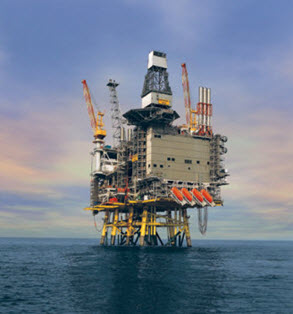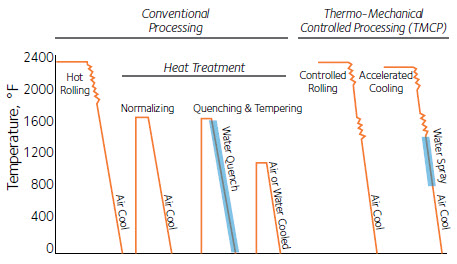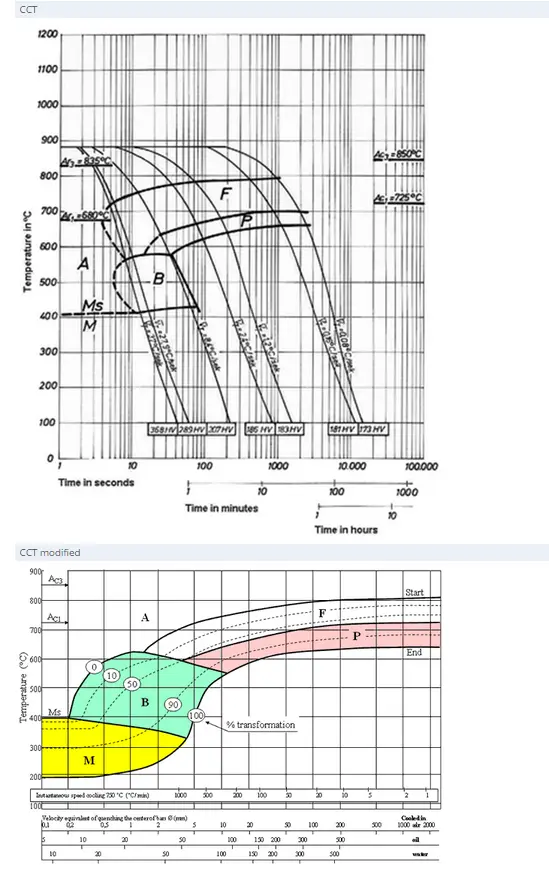TMCP Steel for Offshore Structures: Part One
Abstract
Thermo-Mechanical Control Process (TMCP) steel represents a revolutionary advancement in offshore structural steel manufacturing, offering superior strength, toughness, and weldability compared to conventional carbon-manganese steels. Developed in the late 1970s and early 1980s, TMCP technology combines controlled rolling with accelerated cooling to produce fine-grain microstructures that meet stringent offshore construction requirements. This manufacturing process eliminates the need for costly heat treatment while delivering enhanced mechanical properties at reduced costs. TMCP steels comply with major international standards including API 2W, prEN 10225, BS 7191, and NORSOK specifications, making them ideal for offshore platform construction in challenging marine environments worldwide.
Introduction to Offshore Structural Steel Requirements
The demanding requirements for structural steel plates used in offshore constructions vary significantly based on application fields and operational locations. Modern offshore environments present unique challenges that require specialized steel grades capable of withstanding extreme conditions while maintaining structural integrity throughout extended service lives.
Contemporary offshore construction relies on four major international standards that define the stringent requirements for structural steel plates beyond traditional shipbuilding specifications. These standards ensure that offshore steel structures can withstand the harsh marine environment while providing reliable performance for decades of operation.
Classification of High-Strength Offshore Structural Steels
High-strength structural steels designed for offshore fabrication applications can be categorized into three primary classifications, each offering distinct advantages for specific construction requirements. Carbon steel, typically carbon-manganese compositions, undergoes heat treatment processes to enhance mechanical properties and achieve the strength levels required for offshore applications.
Low-alloy, high-strength steel represents another category that often incorporates heat treatment to optimize performance characteristics. These steels combine controlled alloy additions with specialized processing to achieve superior strength-to-weight ratios essential for offshore platform construction.
Precipitation-hardening steel, exemplified by A710 grade specifications, utilizes controlled heat treatment processes to develop exceptional strength properties through precise microstructural control. This category provides outstanding performance for critical offshore structural components requiring maximum reliability.
International Standards and Regional Applications
The requirements for structural steel plates in offshore constructions differ substantially due to varying application fields and geographic locations where these structures operate. Four major standards currently exist alongside traditional shipbuilding specifications, each addressing the severe requirements imposed on structural steel plates for offshore construction projects.
European offshore applications, particularly in North Sea environments, primarily utilize the prEN 10225, BS 7191, and NORSOK (Norwegian standards) material data sheets. These standards reflect the specific challenges posed by North Sea conditions and have been developed through extensive experience with offshore platform construction in this region.

Figure 1: The Britannia offshore platform in the North Sea as an example of successful TMCP steel application
The API standard finds primary application in American and Asian offshore regions, though different standards may be applied in various global locations depending on project requirements and regulatory frameworks. Notably, these standards demonstrate considerable overlap in their requirements, with NORSOK standards referencing prEN 10225, which itself builds upon BS 7191 specifications.
The convergence of international standards simplifies the development process for steel fabricators working with engineering companies to create improved steel grades in economically viable ways. This standardization trend benefits the entire offshore construction industry by reducing complexity and improving cost-effectiveness.
TMCP Steel Development and Manufacturing Innovation
Steelmakers have developed and refined innovative processes for producing low-carbon, low-impurity, high-strength steel plates that deliver exceptional toughness and improved weldability at competitive costs. This technological advancement represents a fundamental shift in offshore steel manufacturing, exemplified by the new API 2W steel specification.
The API 2W specification was specifically developed to capitalize on breakthrough steelmaking technologies, enabling the production of superior steel grades for offshore applications. Thermo-Mechanical Control Process steels, commonly referred to as TMCP steels, offer an effective cost-saving approach for offshore structure fabrication while delivering enhanced performance characteristics.
TMCP steel technology provides improved weldability, greater strength, and superior toughness compared to conventional carbon-manganese normalized steels, often at equivalent or reduced costs. This combination of enhanced performance and economic benefits has made TMCP steels increasingly popular for offshore construction projects worldwide.
Historical Development and Microstructural Characteristics
TMCP steels emerged during the late 1970s and early 1980s as a response to increasing demands for high-performance structural materials in offshore applications. These steels are characterized by exceptionally fine grain microstructures, typically achieving ASTM 10-12 grain sizes that contribute significantly to their superior mechanical properties.
The fine-grain microstructure enables TMCP steels to achieve higher strength and toughness levels compared to conventional carbon-manganese, micro-alloyed, and heat-treated steels. This microstructural refinement occurs through precise control of the manufacturing process, eliminating the need for expensive post-rolling heat treatment operations.
Economic advantages of TMCP steel production become apparent when comparing total manufacturing costs with conventional carbon-manganese normalized structural steels. The elimination of heat treatment requirements more than compensates for the additional costs associated with controlled rolling and accelerated cooling processes, resulting in overall cost savings for steel producers and end users.
Understanding TMCP Technology and Process Control
Traditionally, hot rolling processes focused solely on achieving specified nominal dimensions including thickness, width, and length parameters. When quality requirements became more stringent, manufacturers added offline heat treatment processes such as normalizing or quench and tempering to achieve desired mechanical properties.
As quality requirements became increasingly severe, the steel industry developed new plate rolling processes that evolved into what is now recognized as TMCP technology. The TMCP process requires total control during three critical phases: slab reheating, plate rolling operations, and post-rolling cooling procedures.
According to the precise definition established by IACS (International Association of Classification Societies), TMCP encompasses both TMR (Thermo-Mechanical Rolling) and AcC (Accelerated Cooling) processes. However, industry professionals commonly use the term TMCP when referring specifically to accelerated cooling applications.
TMCP Processing Routes and Manufacturing Methods
The standard TMCP steel processing route combines controlled rolling techniques with controlled accelerated cooling methods to achieve optimal microstructural development. This integrated approach enables precise control over grain refinement and mechanical property development throughout the steel plate cross-section.

Figure 2: Schematic diagrams comparing conventional processing, conventional controlled rolled (CCR) processing, and TMCP steel processing methods.
The controlled rolling phase involves precise temperature control during the rolling process, typically maintaining specific temperature ranges that promote optimal grain refinement. This is followed by accelerated cooling, which rapidly reduces the steel temperature to lock in the desired microstructural characteristics and prevent undesirable phase transformations.
The combination of controlled rolling and accelerated cooling eliminates the need for subsequent heat treatment while achieving superior mechanical properties compared to conventional processing methods. This integrated approach represents a fundamental advancement in steel plate manufacturing technology for offshore applications.
Benefits and Economic Advantages of TMCP Technology
TMCP steel technology offers numerous advantages that make it particularly attractive for offshore construction applications. The elimination of heat treatment requirements provides immediate cost savings while enabling the production of steel plates with superior mechanical properties.
Enhanced weldability represents another significant benefit, reducing welding complexity and improving joint quality in offshore structure fabrication. The fine-grain microstructure contributes to excellent low-temperature toughness, essential for offshore platforms operating in cold marine environments.
The combination of improved mechanical properties, reduced manufacturing costs, and enhanced fabrication characteristics positions TMCP steels as the preferred choice for modern offshore construction projects. These advantages support the continued growth and adoption of TMCP technology in the global offshore construction industry.
Find Instantly Thousands of Heat Treatment Diagrams!
Total Materia Horizon contains heat treatment details for hundreds of thousands of materials, hardenability diagrams, hardness tempering, TTT and CCT diagrams, and much more.

Get a FREE test account at Total Materia Horizon and join a community of over 500,000 users from more than 120 countries.